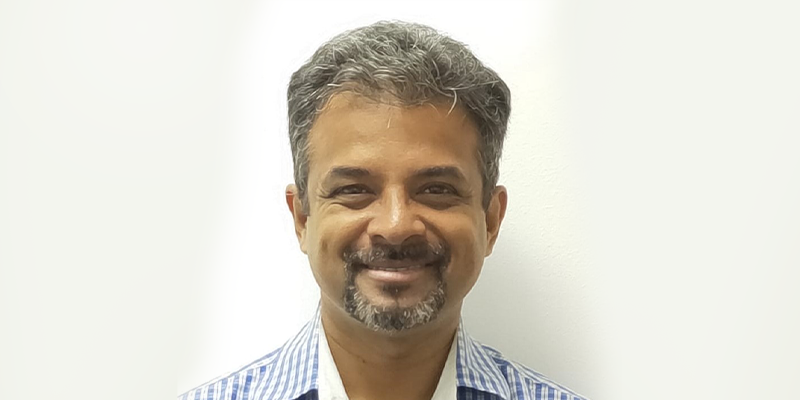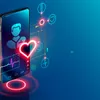A national level athlete and yoga practitioner met with a car accident way back in 1998, which left him severely disabled. This led him on a quest to provide hope to individuals, especially people who have suffered stroke, that they could get back to their normal physical self.
Fifteen years after the incident, in 2013, Dr Subhasis Banerjee founded SynPHNe. The Singapore-based digital neurological therapeutics startup has developed a wearable device to guide stroke patients to follow correct movements so that the recovery process is faster.

Subhasis Banerji, founder of SynPhNe Pte Ltd
SynPhNe’s wearable device was first introduced in 2017, and one of the large hospitals in Singapore adopted it. It has also got approval from US FDA. The devices come under the brand name of eNabl and Xpert.
The start
An engineer by training and running his own business in Mumbai, Dr Subhasis had a life altering course following the accident where he was told by doctors that he would have to continue living in that condition. This led him to experiment with various forms of therapy, which allowed him to walk in about six months’ time after the accident, but it was not normal.
One thing led to another and he landed in Singapore.
“I came to Singapore in 2007 to study bio-medical engineering to understand whether there can be further recovery,” says Subhasis.
It took seven years for me to study and understand the complex interplay between the human body and technology. This led to the founding of SynPhNe in December 2013, where further research would go into coming out with a wearable device.
Solving a bigger problem
The challenges faced by stroke patients are quite severe. According to SynPhNe, in a country like India, there is upwards of seven million such patients, which is regarded as traumatic brain injury, with 60 percent of them being chronic, while the number of therapists stands at around 35,000.
Even in a developed economy like Singapore, which boasts of very advanced healthcare systems, there are estimated 2.5 lakh patients who need daily therapy, with 8,000 new cases every year.
“It is no more an old man’s problem with both genders being affected. We have a billion people in the world living with brain muscle dysfunction,” says Subhasis.
The device
The startup’s wearable device is a set of sensors, which are attached to the arm and head to track the electrical activity in the brain and the muscle linkages. The software in the device captures the signals and guides the affected patient through a set of exercises based on their readings and reactions.
The software gives inputs on good and bad reactions. For example, most disabled people hold their breath when they are trying to move, and this is actually not helpful in recovery. SynPhNe’s wearable device corrects a lot of such actions.
“Our device is a patient-led protocol, where the individual can take it home and do the exercises, which helps in the recovery,” says Subhasis.
Given the enormity of the challenge in treating patients with brain muscle dysfunction, especially those suffering from stroke, SynPhNe wants to create centres where people can come and experience the product, train themselves, and then take it home.
The startup has already launched a centre in Singapore, which is operated by non-therapists.
India plans
The plans are not restricted to Singapore as the startup is very keen to expand into the India market. It did some early trials way back in 2014 in New Delhi, and now it has got an established presence in Mumbai.
Abhijeet D Pandit, Director & CEO, VP Global Network Dev. & Marketing, SynPhNe, says, “The ratio of patients to therapists is unlikely to change anytime soon in the near future, and we need to create that infrastructure where patients are able to access our devices and services.”
Towards this end, SynPhNe opened its fully-owned centre in South Mumbai in July 2019, where patients can take their treatment. “This will be used as a test bed to create outcomes and this is the model we will be taking everywhere,” says Abhijeet.
The focus is on delivering the right experience and getting the desired outcome. The Mumbai centre does around 8-10 therapies a day, which are mainly stroke related, but also looks at some cases of Parkinson’s.
Besides creating its own network of centres, SynPhNe also plans to go through the hospital route where it will enter into partnerships.
Abhijeet says, “About 50 percent of our patients are below the age of 50. This was a startling revelation to us, and it is a population which is keen to get back to work.”
The charges of using this device is slightly higher than what a conventional therapy would cost at a hospital as SynPhNe says it provides a more detailed assessment with much more valuable inputs. “The cost factor never comes up for discussion with our patients,” claims Abhijeet.
According to this startup, the Mumbai centre is profitable on a standalone basis, and expects the price of the device to come down with increased number of users.
Funding
SynPhNe has till now cumulatively raised $5 million, out of which $1 million came through research grants, and the rest from angel investors. It is planning to raise $5.25 million as institutional funding this year.
“Since we started, our idea was to raise institutional series funding until we are ready for commercial launch. We have now got institutional commitment for half,” says Subhasis.
As part of its future plans, SynPhNe plans to treat other medical conditions like cerebral palsy, early Parkinson’s, and children with learning disability.
There are others who have come out with sensor based devices which are in niche categories but SynPhNe says it has got no direct competition.
SynPhNe plans to enter the US market this year, where its device has evinced certain strong interest from medical schools, but these are still early days.
On the challenges encountered in building this venture, Subhasis says, there was certain resistance from the therapists as their job, which was done manually, was being changed to a device-led recovery. Also, there is the need to convince neurologists that patients could recover using the device.
“We are not a therapy-focussed company, but want to give that independence back to the patients. Our 2030 vision is to create a healthcare lifestyle device for the family,” says Subhasis.
(Edited by Megha Reddy)
Want to make your startup journey smooth? YS Education brings a comprehensive Funding Course, where you also get a chance to pitch your business plan to top investors. Click here to know more.
Link : https://yourstory.com/2020/07/startups-wearable-device-stroke-patients-synphne
Author :- Thimmaya Poojary ( )
July 02, 2020 at 05:35AM
YourStory

